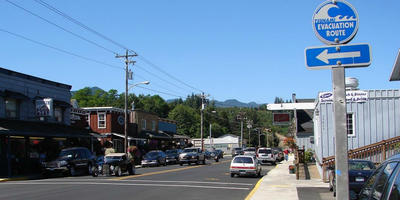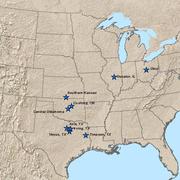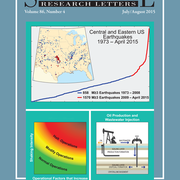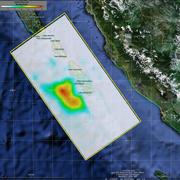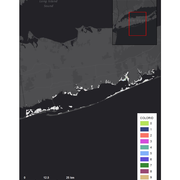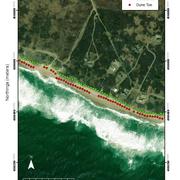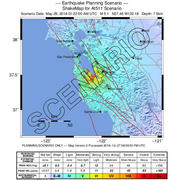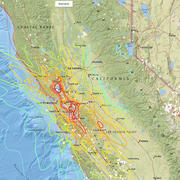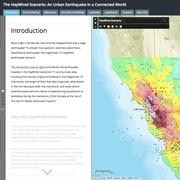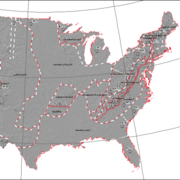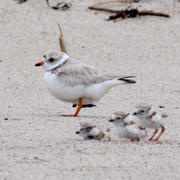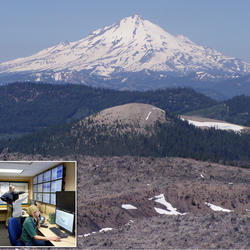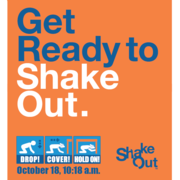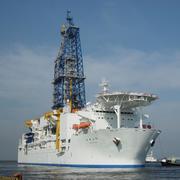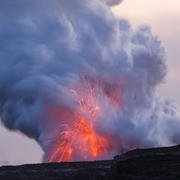Due to a lapse in appropriations, the majority of USGS websites may not be up to date and may not reflect current conditions. Websites displaying real-time data, such as Earthquake and Water and information needed for public health and safety will be updated with limited support. Additionally, USGS will not be able to respond to inquiries until appropriations are enacted. For more information, please see www.doi.gov/shutdown
Mission Areas
Natural Hazards
Mission Areas L2 Landing Page Tabs
Every year in the United States, natural hazards threaten lives and livelihoods and result in billions of dollars in damage. We work with many partners to monitor, assess, and conduct targeted research on a wide range of natural hazards so that policymakers and the public have the understanding they need to enhance preparedness, response, and resilience.
Read Our Science StrategyCosts and consequences of natural hazards can be enormous; each year more people and infrastructure are at risk. We develop and apply hazards science to help protect U.S. safety, security, and economic well being. These scientific observations, analyses, and research are crucial for the Nation to become more resilient to natural hazards.
Read Our Science StrategyOverview
Between the years 1973–2008, there was an average of 25 earthquakes of magnitude three and larger in the central and eastern United States. This rate ballooned to over 600 M3+ earthquakes in 2014 and over 1000 in 2015. Since 2015 the earthquake rate has declined significantly (364 M3+ earthquakes in 2017), but this is still much higher than the natural earthquake rate.
Myths and Misconceptions
What you do and don’t know about induced seismicity.
Observational Studies
The USGS is currently studying seismicity that may be induced at 6 locations across the United States. These studies involve earthquake monitoring, examining industrial data, and evaluating any relationships between seismicity and industrial actions.
Hazard Estimation
The USGS is currently developing new methods to evaluate the hazard due to induced earthquakes. These methods will account for the rapid changes in earthquake rate that we have witnessed in the past few years.
Numerical Modeling
The USGS uses numerical simulations of earth processes to: Evaluate the physical relationships between fluid injection and earthquakes at specific sites, and to simulate possible future behaviors of new and ongoing injection projects.
Publications
USGS publications on induced seismicity.
Preliminary simulation of the 2010 tsunami in Indonesia
Preliminary simulation of the tsunami from the October 25, 2010 M=7.7 subduction zone earthquake offshore of the Mentawai Islands, Indonesia
Tribal Land Vegetation and Watershed Modeling
San Carlos Apache Reservation covers 1.8 million acres in east-central Arizona, and has diverse ecosystems and vegetation types that support a natural resource-based economy.
Journey Along a Fieldline
A comic book that introduces the basics of geomagnetism.
View the comic book (PDF).
Hurricane Sandy Response- Linking the Delmarva Peninsula's Geologic Framework to Coastal Vulnerability
The Delmarva Peninsula is a 220-kilometer-long headland, spit, and barrier island complex that was significantly affected by Hurricane Sandy. In order to better constrain controls on coastal vulnerability and evolution, the region’s sediment sources, transport pathways and sediment sinks must be identified. This project defines the geologic framework of the Delmarva coastal system through...
San Francisco Bay Area - East Bay (BALT1) Site near Castro Valley, CA
Recent Conditions
The instruments were installed in the spring of 2009 and are used to monitor and detect changes in local conditions. Soil water content and ground water pressure are monitored at two nests on the same hillslope. Data for the site include:
- Rainfall ...
Using Video Imagery to Study Wave Dynamics: Isla Verde
Four video cameras overlook the coast at Isla Verde in San Juan, Puerto Rico. Two of them focus on the shoreline: Camera 1 looks at the nearby beach and eastward along the shore, and Camera 2 looks farther away to the eastern end of the beach. The other two look out across the reefs: Camera 3 to the north-northwest, and Camera 4 to the northeast.
Oceanographic and Water Quality Measurements in two Southern California Coastal Wetlands, 2013-2014
The objective was to compare an urbanized wetland with limited sediment supply (Seal Beach) with a less modified marsh (Pt. Mugu) with fluvial sediment supply. Marine temperature, conductivity, pressure sensors, optical turbidity sensors and acoustic velocity meters were deployed on bottom platforms to quantify the conditions in the water column.
Oceanographic, Atmospheric and Water-Quality Measurements Sandwich Town Neck Beach, Massachusetts, 2016
These measurements provide information about waves, tides, and overwash during a winter storm in January 2016; about waves, tides, currents, and water properties between February and May, 2016; and about waves and tides between May and June 2016, during a period that overlaps with offshore bathymetric surveys.
Oceanographic, Atmospheric and Water-Quality Measurements Sandwich Town Neck Beach, Massachusetts, 2017
These measurements provide short-duration datasets of waves, tides, and overwash from portable pressure sensors deployed on the beach during major winter storms on these dates: January 23-26; February 9-10; February 13-15; and March 13-15, 2017. Longer datasets were obtained from sensors on a platform deployed on the seafloor north of the beach in seven meters depth.
Oceanographic and Water Quality Measurements Collected in Grand Bay, Alabama/Mississippi, August 2016 – January 2017
Suspended-sediment transport is a critical element governing the geomorphology of tidal marshes and estuaries. Marshes rely both on organic material and inorganic sediment deposition to maintain their elevation relative to sea-level. Additionally, horizontal marsh extent is altered by lateral erosion and accretion.
Massachusetts Shoreline Change Project: A GIS Compilation of Vector Shorelines for the 2018 update
The Massachusetts Office of Coastal Zone Management launched the Shoreline Change Project in 1989 to identify erosion-prone areas of the coast. The shoreline position and change rate are used to inform management decisions regarding the erosion of coastal resources.
Geospatial Data Layers of Shallow Geology, Sea-Floor Texture, and Physiographic Zones from the Inner Continental Shelf of Martha’s Vineyard from Aquinnah to Wasque Point, and Nantucket from Eel Point to Great Point
Geologic, sediment texture, and physiographic zone maps characterize the sea floor south and west of Martha's Vineyard and north of Nantucket, Massachusetts. These maps were derived from interpretations of seismic-reflection profiles, high-resolution bathymetry, acoustic-backscatter intensity, bottom photographs, and surficial sediment samples.
Elevation of marsh units in Fire Island National Seashore and Central Great South Bay salt marsh complex, New York
Elevation distribution in the Fire Island National Seashore and Central Great South Bay salt marsh complex is given in terms of mean elevation of conceptual marsh units defined by Defne and Ganju (2018). The elevation data is based on the 1-meter resolution Coastal National Elevation Database (CoNED).
Conceptual marsh units for Fire Island National Seashore and central Great South Bay salt marsh complex, New York
The salt marsh complex of Fire Island National Seashore (FIIS) and central Great South Bay was delineated to smaller, conceptual marsh units by geoprocessing of surface elevation data. Flow accumulation based on the relative elevation of each location is used to determine the ridge lines that separate each marsh unit
Temporal hydrologic and chemical records from the Ox Bel Ha cave network within the coastal aquifer of the Yucatan Peninsula, from January 2015 to January 2016
Natural cave passages penetrating a coastal aquifer in the Yucatan Peninsula (Mexico) were accessed to investigate how regional meteorology and hydrology control methane dynamics in karst subterranean estuaries. Three field trips were carried out in January 2015, June 2015, and January 2016 to obtain year-long high-resolution temporal records of water chemistry and environmental parameters
Dune Metrics for the Massachusetts Coast as Derived From 2013–14 Topographic Lidar Data
This data release, which is part of the 2018 update, defines the position and elevation of the most seaward dune crest and toe along the Massachusetts coast as derived from 2013–14 lidar data. In the absence of a dune, the peak of the berm or the seaward edge of a bluff, headland, or hard structure (for example, a seawall, road, or parking lot) was chosen as a proxy for the dune crest.
High-resolution geophysical data collected in Lake Powell, Utah-Arizona, U.S. Geological Survey Field Activity 2017-049-FA
High-resolution geophysical mapping of Lake Powell in the Glen Canyon National Recreation Area in Utah and Arizona was conducted between October 8 and November 15, 2017, as part of a collaborative effort between the U.S. Geological Survey and the Bureau of Reclamation to provide high-quality data needed to reassess the area-capacity tables for the Lake Powell reservoir.
Mean tidal range in marsh units of Assateague Island National Seashore and Chincoteague Bay, Maryland and Virginia
This dataset displays the spatial variation of mean tidal range (i.e. Mean Range of Tides, MN) in the Assateague Island National Seashore and Chincoteague Bay based on conceptual marsh units defined by Defne and Ganju (2018). MN was based on the calculated difference in height between mean high water (MHW) and mean low water (MLW) using the VDatum (v3.5) database (...
Seabed maps showing topography, ruggedness, backscatter intensity, sediment mobility, and the distribution of geologic substrates in Quadrangle 6 of the Stellwagen Bank National Marine Sanctuary Region offshore of Boston, Massachusetts
The U.S. Geological Survey (USGS), in cooperation with the National Oceanic and Atmospheric Administration's National Marine Sanctuary Program, has conducted seabed mapping and related research in the Stellwagen Bank National Marine Sanctuary (SBNMS) region since 1993.
Earthquake outlook for the San Francisco Bay region 2014–2043
Using information from recent earthquakes, improved mapping of active faults, and a new model for estimating earthquake probabilities, the 2014 Working Group on California Earthquake Probabilities updated the 30-year earthquake forecast for California. They concluded that there is a 72 percent probability (or likelihood) of at least one earthquake of magnitude 6.7 or greater striking somewhere in
Digital database of recently active traces of the Hayward Fault, California
This map shows the location of and evidence for recent movement on active fault traces within the Hayward Fault Zone, California.
HayWired aftershock (M> 5) ShakeMaps
The maps in this archive display estimated intensities and ground motions for the largest earthquakes in the HayWired aftershock sequence. The aftershock sequence follows the HayWired M7.0 mainshock that is imagined to occur on April 18, 2018 along the Hayward Fault.These maps have been used in analyses of the HayWired scenario.
Ground motion and regional information of the M 7.0 mainshock
The HayWired scenario depicts a hypothetical M7.0 earthquake on California’s Hayward Fault. This site includes an interactive map showing fault traces and ShakeMap contours, information on the tectonic setting of the Hayward Fault and fault rupture history; and a USGS ShakeMap, which provides ground motion information for the HayWired scenario mainshock.
The HayWired Scenario: An Urban Earthquake in a Connected World - A Geonarrative
What might it be like the next time the Hayward Fault has a large earthquake? A geonarrative and related imagery examines a hypothetical earthquake, the magnitude 7.0 HayWired earthquake scenario.
Regional Conductivity Maps
Location of 1D Earth Resistivity Models with respect to Physiographic Regions of the USA
Data from Earthquake-Induced Landslide Hazards for a M7.0 Scenario Earthquake on the Hayward Fault
The seismic-landslide probability map covers the counties of Alameda, Contra Costa, Marin, Napa, San Francisco, San Mateo, Santa Clara, Santa Cruz, Solano, and Sonoma. The slope failures are triggered by a hypothetical earthquake with a moment magnitude of 7.0 occurring on April 18, 2018, at 4:18 p.m. on the Hayward Fault in the east bay part of California’s San Francisco Bay region.
Map of America's Submerged Lands
Links to publications that contain maps of the sea floor or lake beds and the digital data used to create them.
Coastal and Marine Geology Program Interactive Maps
This portal is a “go to” source for maps related to ocean and coastal mapping. Information is organized by geography or region, by theme, and by the year data was published.
Interactive Flood Map
Maps of flood and high flow conditions within the U.S.
On the potential duration of the aftershock sequence of the 2018 Anchorage earthquake
Currently, an aftershock sequence is ongoing in Alaska after the magnitude 7.0 Anchorage earthquake of November 30, 2018. Using two scenarios, determined with observations as of December 14, 2018, this report estimates that it will take between 2.5 years and 3 decades before the rate of aftershocks decays to the rate of earthquakes that were...
Michael, Andrew J.Earthquakes induced by hydraulic fracturing are pervasive in Oklahoma
Wastewater disposal is generally accepted to be the primary cause of the increased seismicity rate in Oklahoma within the past decade, but no statewide analysis has investigated the contribution of hydraulic fracturing (HF) to the observed seismicity or the seismic hazard. Utilizing an enhanced seismicity catalog generated with multi‐station...
Skoumal, Robert J.; Ries, Rosamiel; Brudzinski, Michael R.; Barbour, Andrew J.; Currie, Brian S.Microseismic events associated with the Oroville Dam spillway
On 14 February 2017, two small (equivalent MD 0.8 and 1.0) seismic events occurred in proximity to the Oroville Dam in the Sierra Nevada foothills, California. To examine possible causal relationships between these events and reservoir operations, including the spillway failure starting prior to these events, we applied a new optimized template...
Skoumal, Robert J.; Dawson, Phillip B.; Hickman, Stephen H.; Kaven, J. OleGround motions from induced earthquakes in Oklahoma and Kansas
Improved predictions of earthquake ground motions are critical to advancing seismic hazard analyses and earthquake response. The high seismicity rate from 2009 to 2016 in Oklahoma and Kansas provides an extensive data set for examining the ground motions from these events. We evaluate the ability of three suites of ground‐motion prediction...
Moschetti, Morgan P.; Thompson, Eric M.; Powers, Peter M.; Hoover, Susan M.; McNamara, Daniel E.Global Earthquake Model (GEM) Risk Map
The Global Earthquake Risk Map (v2018.1) comprises four global maps. The main map presents the geographic distribution of average annual loss (USD) normalized by the average construction costs of the respective country (USD/m2 due to ground shaking in the residential, commercial and industrial building stock, considering contents, structural...
Silva, V.; Amo-Oduro, D.; Calderon, A.; Dabbeek, J.; Despotaki, V.; Martins, L.; Rao, A.; Simionato, M.; Vigano, D.; Yepes, C.; Acevedo, A.; Crowley, H.; Horspool, Nick; Jaiswal, Kishor; Journeay, M.; Pittore, M.Serpentinite‐rich gouge in a creeping segment of the Bartlett Springs Fault, northern California: Comparison with SAFOD and implications for seismic hazard
An exposure of a creeping segment of the Bartlett Springs Fault (BSF), part of the San Andreas Fault system in northern California, is a ~1.5‐m‐wide zone of serpentinite‐bearing fault gouge cutting through Late Pleistocene fluvial deposits. The fault gouge consists of porphyroclasts of antigorite serpentinite, talc, chlorite, and tremolite‐...
Moore, Diane E.; McLaughlin, Robert J.; Lienkaemper, James J.Honolulu Magnetic Observatory
Tucked in a grove of thorny mesquite trees, on an ancient coral reef on the south side of the Hawaiian island of Oahu, west of Pearl Harbor, a small unmanned observatory quietly records the Earth’s time-varying magnetic field. The Honolulu Magnetic Observatory is 1 of 14 that the U.S. Geological Survey Geomagnetism Program operates at various...
Love, Jeffrey J.; Finn, Carol A.Image mosaic and topographic maps of Mercury
Map DescriptionsSheet 1: This image mosaic is based on observations acquired by the Mercury Dual Imaging System (MDIS; Hawkins and others, 2009), an instrument on the National Aeronautics and Space Agency (NASA) MErcury Surface, Space ENvironment, Geochemistry, and Ranging (MESSENGER) spacecraft (Solomon and others, 2007). The Mercator projection...
Hunter, Marc A.; Hare, Trent M.; Hayward, Rosalyn K.; Chabot, Nancy L.; Hash, Christopher D.; Denevi, Brett W.; Ernst, Carolyn M.; Murchie, Scott L.; Blewett, David T.; Malaret, Erick R.; Solomon, Sean C.; Becker, Kris J.; Becker, Tammy L.; Weller, Lynn A.; Edmundson, Kenneth L.; Neuman, Gregory A.; Mazarico, Erwan; Perry, Mark E.Ground motions from the 7 and 19 September, 2017 Tehuantepec and Puebla-Morelos, Mexico, earthquakes
The 2017 M">M 8.2 Tehuantepec and M">M 7.1 Puebla‐Morelos earthquakes were deep inslab normal‐faulting events that caused significant damage to several central‐to‐southern regions of Mexico. Inslab earthquakes are an important component of seismicity and seismic hazard in Mexico. Ground‐motion prediction equations (GMPEs...
Sahakian, Valerie J.; Melgar, Diego; Quintanar, Luis; Ramirez-Guzman, Leonardo; Pérez-Campos, Xyoli; Baltay, Annemarie S.Tropical storm-induced landslide potential using combined field monitoring and numerical modeling
When heavy rainfall, such as that associated with tropical storms, falls on steep hillsides, shallow landslides are often one of the damaging consequences. To assess landslide potential from heavy rainfall, a strategy of combined numerical simulation and field monitoring of variably saturated hillslope conditions is developed. To test the combined...
Chen, Pan; Lu, Ning; Formetta, Giuseppe; Godt, Jonathan W.; Wayllace, AlexandraClimate dictates magnitude of asymmetry in soil depth and hillslope gradient
Hillslope asymmetry is often attributed to differential eco‐hydro‐geomorphic processes resulting from aspect‐related differences in insolation. At midlatitudes, polar facing hillslopes are steeper, wetter, have denser vegetation, and deeper soils than their equatorial facing counterparts. We propose that at regional scales, the magnitude in...
Inbar, Assaf; Nyman, Petter; Rengers, Francis K.; Lane, Patrick N. J.; Sheridan, Gary J.Mars global digital dune database (MGD3)—Composition, stability, and thermal inertia
The Mars Global Digital Dune Database (MGD3) is an online repository that has catalogued dune fields larger than 1 km2 located between latitudes 90° N. and 90° S. The work presented here expands upon previous MGD3 open-file reports, with a new emphasis upon characterizing dune fields through composition, stability, and thermal inertia. Included in...
Gullikson, Amber L.; Hayward, Rosalyn K.; Titus, Timothy N.; Charles, Heather; Fenton, Lori K.; Hoover, Rachael H.; Putzig, Nathaniel E.SEA-MAT: Matlab Tools for Oceanographic Analysis
A collaborative effort to organize and distribute Matlab tools for the Oceanographic Community
bi-transect-extractor
This package is used to calculate coastal geomorphology variables along shore-normal transects. The calculated variables are used as inputs for modeling geomorphology using a Bayesian Network (BN).
iPlover
iPlover was developed by the U.S. Geological Survey Woods Hole Coastal and Marine Science Center and the USGS Center for Integrated Data Analytics. It is used by trained and vetted personnel to record information about habitats on coastal beaches and he environment surrounding them.
THRESH
Software for tracking rainfall thresholds for landslide and debris-flow occurrence, user manual.
Earthquake Software
Designed to facilitate the study of earthquakes, faults, and seismic related events.
Landslide software
Various software designed for landslide assessments and modeling.
Scoops3D
Scoops3D is software to analyze three-dimensional slope stability throughout a digital landscape.
SLAMMER
SLAMMER is a Java program that facilitates performing a variety of sliding-block analyses to evaluate seismic slope performance.
TRIGRS
A Fortran Program for Transient Rainfall Infiltration and Grid-Based Regional Slope-Stability Analysis, Version 2.0.
PTCOUNT
A Fortran-77 Computer Program to Calculate the Areal Distribution of Mapped Data Points Using Count-Circle Methodology.
JanbuGS, BishopGS, and FelleniusGS
Fortran-77 programs for limit-equilibrium slope-stability analysis.
Displaying fixed bin options for rates of change
Displaying fixed bin options (left) for rates of change for an example dataset (LRR, EPR, WLR), and scaled to data (right) (NSM).
Map of volcano threat category designated by color
Map showing the locations of all U.S. volcanoes with their threat category designated by color. Very high threat is red, high is orange, moderate is yellow, low is green, and very low is blue.
Piping Plover Habitat, Cedar Island
The beach-dependent shorebirds project at the Woods Hole Coastal and Marine Science Center models current and future habitat availability for nesting shorebirds in an effort to map current and likely future habitat availability on a range of sites along the U.S. Atlantic coast. Sites include beaches with minimal human-presence, such Cedar Island shown here off of the
...Data visualization with scaled options applied
Data visualization with (A) fixed and (B) scaled options applied. Examples of NSM and SCE are also displayed (C and D respectively). The data itself has not changed – only the scaling and statistic selected through the DSAS Data Visualization tool.
Map of the Martha’s Vineyard and Nantucket study sites outlined in red
Map of the Martha’s Vineyard and Nantucket study sites outlined in red.
DSAS Summary Report
Example of a section of DSAS summary report highlighting the use of DSAS_group to organize output statistics.
Mount Shasta, a steep-sided Cascade Range stratovolcano in Northern Ca
Mount Shasta, a steep-sided Cascade Range stratovolcano in Northern California, looms above Little Glass Mountain, a thick obsidian flow erupted from the Medicine Lake shield volcano about 1,000 years ago. These are just two of the young volcanic areas monitored by the USGS California Volcano Observatory. USGS photo.
Seismic Collage
Image showing a collage of examples of multi-channel and single-channel seismic data collected by the USGS, seismic equipment deployed from a research vessel, and seismic equipment on a research vessel. These data are critical to the CMG Program as they define the geology in marine and coastal environments.
ShakeAlert sensor station being serviced by USGS personnel
A USGS electronics technician performs maintenance on a ShakeAlert Earthquake Early Warning (EEW) sensor station, located in the San Francisco Bay Area. ShakeAlert station components include strong-motion accelerometers, solar panel and battery power systems, and communications & telemetry equipment for communication with the wider ShakeAlert network.
UAS pilots at Kilauea
Department of Interior UAS pilots from left to right – Elizabeth Pendleton (USGS, Woods Hole, MA), Colin Milone (Office of Aviation Services, AK), John Vogel (USGS; Flagstaff, AZ), Sandy Brosnahan (USGS, Woods Hole, MA), Brandon Forbes (USGS; Tuscon, AZ), Chris Holmquist-Johnson
...SEABOSS Collage
SEABed Observation and Sampling System (SEABOSS) (center image) and the MiniSEABOSS (right) designed for rapid, inexpensive, and effective collection of seabed imagery (photographs and video) as well sediment samples from the coastal/inner-continental shelf regions. Images from coastal Massachusetts show purple algae-encrusted cobbles and boulders covered with sea-stars (
...Screenshot of Our Coast, Our Future
Screenshot of Our Coast, Our Future (OCOF) interactive map view of Stinson Beach, California, showing extent of flooding predicted if subjected to a sea-level rise of 100 centimeters (about 40 inches) and elevated water levels caused by a 100-year storm.
Which U.S. volcanoes pose a threat?
USGS Volcanic Threat Assessment updates the 2005 rankings.
Anchialine Biogeochemistry Research Team returns to the Yucatan Peninsula, Mexico
The Anchialine Biogeochemistry Research Team has returned to the Yucatan Peninsula Mexico to continue investigating how life persists within underwater coastal caves beneath the tropical forest.
2018 Anchorage Earthquake
A magnitude 7.0 earthquake struck north of Anchorage, Alaska, on November 30, 2018, at 8:29 a.m. local time (17:29:28 UTC). For the most up-to-date information, please visit the USGS event page, and for estimates of casualties and damage, visit the USGS Prompt Assessment of Global Earthquakes for Response (PAGER) website.
The Woods Hole Coastal and Marine Science Center Aerial Imaging and Mapping Group Aids in Monitoring and Mapping the Kīlauea Volcanic Eruption
On May 3, 2018, Kīlauea, one of the world’s most active volcanoes, began an over three-month-long eruption. Tina Neal and the rest of her team at the U.S. Geological Survey Hawaiian Volcano Observatory (HVO) have been spearheading all Kīlauea monitoring and data-analysis efforts, and continue to provide regular updates on the status...
USGS Working to Restore Streamgages
For questions about a streamgage in your state, please contact your local USGS water science center; contacts can be found at https://water.usgs.gov/key_officials.html.
Before and After: Coastal Change Caused by Hurricane Michael
To learn more about USGS’ role providing science to decision makers before, during and after Hurricane Michael, visit the USGS Hurricane Michael page at https://usgs.gov/hurricane-michael.
The Hayward Fault—Is It Due for a Repeat of the Powerful 1868 Earthquake?
By Thomas M. Brocher, Jack Boatwright, James J. Lienkaemper, Carol S. Prentice, David P. Schwartz, and Howard Bundock
Drawn from: USGS Fact Sheet 2018-3052
The Great ShakeOut! -- 2018 Edition
Do you know what to do the moment the ground starts shaking? Drop, Cover, and Hold On!
Debris - Flow Forecasts Before Wildfires
USGS scientists have been pursuing a way to assess debris flow hazards before a fire occurs.
GeoGirls Rock! USGS women encourage and support the next generation of scientists
Mount St. Helens volcano loomed in the distance as 25 middle-school “GeoGirls” signed in, received a name tag, dropped their overnight gear and gathered in a grassy open space to meet camp staff, women scientists and volunteers.
National Earthquake Information Center (NEIC) Leads Meeting on the Future of Earthquake Research and Monitoring
What are the next goals for the NEIC?
USGS scientists provide input for workshop on scientific drilling targets in the north Pacific Ocean
Pacific Coastal and Marine Science Center research geologist Danny Brothers attended the International Ocean Discovery Program (IODP) workshop on the “Scientific Exploration of the Arctic and North Pacific” September 25–27 in Mt. Hood, Oregon.


